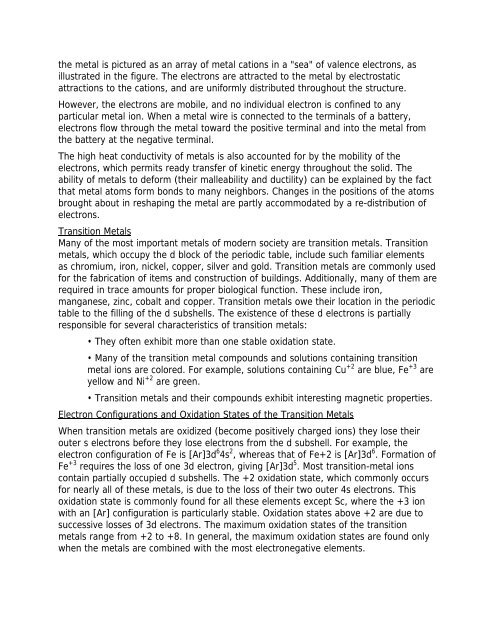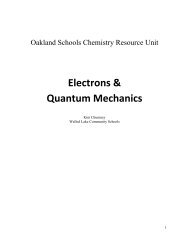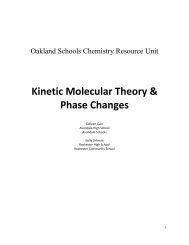Create successful ePaper yourself
Turn your PDF publications into a flip-book with our unique Google optimized e-Paper software.
the metal is pictured as an array of metal cations in a "sea" of valence electrons, as<br />
illustrated in the figure. The electrons are attracted to the metal by electrostatic<br />
attractions to the cations, and are uniformly distributed throughout the structure.<br />
However, the electrons are mobile, and no individual electron is confined to any<br />
particular metal ion. When a metal wire is connected to the terminals of a battery,<br />
electrons flow through the metal toward the positive terminal and into the metal from<br />
the battery at the negative terminal.<br />
The high heat conductivity of metals is also accounted for by the mobility of the<br />
electrons, which permits ready transfer of kinetic energy throughout the solid. The<br />
ability of metals to deform (their malleability and ductility) can be explained by the fact<br />
that metal atoms form bonds to many neighbors. Changes in the positions of the atoms<br />
brought about in reshaping the metal are partly accommodated by a re-distribution of<br />
electrons.<br />
Transition Metals<br />
Many of the most important metals of modern society are transition metals. Transition<br />
metals, which occupy the d block of the periodic table, include such familiar elements<br />
as chromium, iron, nickel, copper, silver and gold. Transition metals are commonly used<br />
for the fabrication of items and construction of buildings. Additionally, many of them are<br />
required in trace amounts for proper biological function. These include iron,<br />
manganese, zinc, cobalt and copper. Transition metals owe their location in the periodic<br />
table to the filling of the d subshells. The existence of these d electrons is partially<br />
responsible for several characteristics of transition metals:<br />
• They often exhibit more than one stable oxidation state.<br />
• Many of the transition metal compounds and solutions containing transition<br />
metal ions are colored. For example, solutions containing Cu +2 are blue, Fe +3 are<br />
yellow and Ni +2 are green.<br />
• Transition metals and their compounds exhibit interesting magnetic properties.<br />
Electron Configurations and Oxidation States of the Transition Metals<br />
When transition metals are oxidized (become positively charged ions) they lose their<br />
outer s electrons before they lose electrons from the d subshell. For example, the<br />
electron configuration of Fe is [Ar]3d 6 4s 2 , whereas that of Fe+2 is [Ar]3d 6 . Formation of<br />
Fe +3 requires the loss of one 3d electron, giving [Ar]3d 5 . Most transition-metal ions<br />
contain partially occupied d subshells. The +2 oxidation state, which commonly occurs<br />
for nearly all of these metals, is due to the loss of their two outer 4s electrons. This<br />
oxidation state is commonly found for all these elements except Sc, where the +3 ion<br />
with an [Ar] configuration is particularly stable. Oxidation states above +2 are due to<br />
successive losses of 3d electrons. The maximum oxidation states of the transition<br />
metals range from +2 to +8. In general, the maximum oxidation states are found only<br />
when the metals are combined with the most electronegative elements.
















